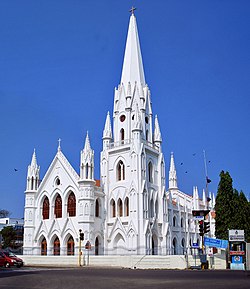Santhome
Santhome
சாந்தோம் | |
|---|---|
neighbourhood | |
 San Thome Basilica | |
| Country | India |
| State | Tamil Nadu |
| District | Chennai District |
| Metro | Chennai |
| Government | |
| • Body | CMDA |
| Languages | |
| • Official | Tamil |
| Time zone | UTC+5:30 (IST) |
| PIN | 600004 |
| Planning agency | CMDA |
| Website | www |
Santhome is a locality in Mylapore in Chennai city (old Madras) in India.
History
The word Santhome or San Thome is derived from Saint Thomas, one of the twelve apostles of Jesus Christ. As per tradition, the apostle landed in Muziris (in Kerala) in A.D. 52, was martyred in A.D.72 at St.Thomas Mount in the city, and was interred in Mylapore. A church was built over his supposed tomb and today is known as the San Thome Basilica. The Basilica is one of the four churches that claim to have been built over the tomb of an apostle. (Others include St. Peter's Basilica in Rome, Italy; the Church of Saint James the Great in Santiago de Compostela, Spain; and the Ghareh Keliseh Monastery of St. Thaddeus in Ghara-Kilise, Iran.)
Commonly known as Santhome Church, the International Shrine of St. Thomas Basilica has an underground tomb chapel where pilgrims can pray in front of the sepulchre of St. Thomas. Superstitious people believe that sand taken from the tomb has miraculous healing powers. Marco Polo the great Venetian traveller visited the tomb in 1292 and made a record of his visit in his travel diaries:
"The Christians who go thither in pilgrimage take of the earth from the place where the saint was killed (or buried), and give a portion thereof to anyone who is sick of a quartan or a tertian fever; and by the power of God and of St. Thomas the sick man is incontinently cured."--Travels of Marco Polo Vol.II by Yule Edited by Cordier.
Faithful people have had to wait many years to get a little sand from the tomb, as it is only opened infrequently, at intervals of a few hundred years.
The church has made a beautiful credit card for pilgrims, the St. Thomas Card,[1] with a little of the St. Thomas sand embedded in it. This can be carried around like a normal credit card in a wallet or purse.
Battle of St Thomé
During the First Carnatic War, after the French captured Fort St George from the British, the Nawab of the Carnatic, Anwaruddin Muhammed Khan, expected the town to be handed over to him as overlord. Anwaruddin responded by sending a 10,000 man army under Mahfuz Kahn, his son, to take the fort from Dupleix by force.
When Kahn's forces approached the walls however, the garrison's gunnery compelled them to retire. French Governor-General Joseph François Dupleix sent a relief force from Pondicherry that met Khan's army at the Adyar River. Although the French had only 300 troops, in the Battle of Adyar they executed a bold attack that drove the Nawab's forces into the town. The French then expelled them and forced them to retreat towards Arcot. By this action the French ceased being suppliants to the local ruler.
Santhome now

Santhome has some premier educational institutions. Hence, it became a administrative capital locality of the Archdiocese of Madras-Mylapore. These include Rosary Matriculation School, St. Bedes A. I. Hr. Sec. School, Santhome Higher Secondary school, St. Raphel's School and Dominic Savio Matric. School. The official residence of the Archbishop of the Madras - Mylapore Archdiocese is in Santhome adjacent to the Basilica. The consulates of Russia and Spain are also in this area. The Santhome High Road stretches from the light house side of the famous Marina beach and goes through in front of St. Thomas basilica towards Adyar.
